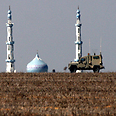
Report: Fewer rockets on Israeli soil since operation Pillar of Defense
Hamas weakened due to regional circumstances; IDF proudly showcases Pillar of Defense achievements: 2013 sees fewer rockets on Israeli territory, loss of capacity in terror organization
As the data are released, this year was "crowned" as the quietest one in the southern region since the outbreak of the Second Intifada in the fall of 2000. If the low firing rate continues into the next several months, 2013 will officially be considered as the calmest in the past dozen years in the south.
Related stories:
- IDF: Israeli drone crashes in Gaza
- IDF to simulate Gaza seizure in Ashkelon drill
- Soldiers leave Gaza-vicinity communities
In comparison, in 2009, the year after Operation Cast Lead, 317 rockets and mortar shells were launched from the Gaza Strip, almost five times the number fired in the past year, and consequently more Israeli casualties from Gaza terror activities were documented.
Last year's figures are even more resonant in light of the difficult years since the IDF withdrawal form Gaza: In 2005, terror organizations launched 1,318 rockets and mortar shells from Gaza (20 times more than this year), a year later the launches added up to 1,777 (times 27), and in 2008, up until December 26, when Operation Cast Lead began, there were 3,716 launches of rockets and mortar shells (56 times more than this year).
The data, largely based on Shin Bet reports, also refer to other terror attacks originated in the Gaza Strip: In the year that has passed since Operation Pillar of Defense, explosives detonated near an IDF force (last week), and five other bombs were found. There were six instances in which there were small arms firings towards soldiers operating near the border, and once, during violent border protests which have become more prominent recently, a Molotov cocktail was tossed in the direction of IDF troops.
In regards to operational activities casualties, the six injured soldiers from last week's event were the only Israelis wounded in the past year from Gaza-based terrorist activity. According to the Shin Bet, in the year following Cast Lead, one soldier was killed, 16 Israelis were injured, and 59 small arms firing events (compared to 227 the year previous to the operation) and 12 anti-tank attacks (compared to 51 such attacks in 2008) were carried out, as well as 16 munitions charge events (compared to 31 the previous year).
Hamas-made rockets
The Southern Command estimated this weekend that the incident in which explosives detonated in a terror tunnel that was revealed a month ago in southern Gaza Strip, killing four Hamas operatives, will not lead to escalation. For the time being, this estimation proves realistic.
Despite optimism, IDF officials have expressed belief that Hamas is far from becoming a friend to the Jewish State. After losing a large portion of its long-ranged rockets during last year's operation, together with losing its capability to receive new rockets through destroyed smuggling tunnels, Hamas is self-producing rockets and executing launching tests. In addition, even though two terror tunnels were uncovered, Israel estimates that the organization has additional large-scale cross-border tunnels, which await their operative signal.
Despite the comparison to Operation Cast Lead, two major elements were not part of the assessment: Israel was not equipped in 2009 with Iron Dome batteries and Hamas enjoyed an inflow of weapons through terrorist tunnels form Sinai at the time. Many of these tunnels were destroyed in recent months by the Egyptian army.
In addition, in 2009, Hamas enjoyed relative regional stability and Iranian support. In the past year, after Hamas replaced its patron from Tehran with the Muslim Brotherhood, which meanwhile collapsed in Cairo, the Gazan organization is in distress, and not only as a result of IDF deterrence following the operation last November.
While Israel expanded the areas of agriculture and fishing and allowed the entry of Khaled Mashal to the Gaza Strip, Hamas established a unit of hundreds of operatives who enforce the prevention of firing at Israel by rogue organizations. Most of the launches in the past year were "vengeful" attacks against Hamas by its opposing organization, the Islamic Jihad.
Take enemy down
The success of Operation Pillar of Defense heightened the debate among IDF chiefs in regards to whether a limited operation, without ground activities, would suffice. Air Force officials repeatedly stated in the past year that IAF aircrafts and drones are capable of taking on a future operation as they did in Operation Pillar of Defense, while the ground forces are convinced that only a ground operation will bare results in Gaza and mainly in Lebanon.
"You cannot reach all launchers, weapon-arsenals and terrorist headquarters solely with the IAF," a senior IDF commander told Ynet lately during a brigade drill. "In order to give Hamas or Hezbollah a fatal blow, the infantry fighters need to touch the enemy, to reach its hiding places, to dismantle its rockets with their own hands. It's also critical for the terms of ceasefire of the operation or war."
This debate is expected to rise in every future operation, as well as how deep should the forces go. During Operation Cast Lead, then Southern Command Chief Yoav Galant asked to expand the operation into southern Gaza, in order to cause a larger blow to Hamas' buildup. The move was not approved, and its influence was evident the years after.
Despite the nature of Pillar of Defense, the duty brigades continued preparing for an extensive ground operation in the past year. IDF is constructing tunnels in its bases in order to train the infantry and engineering forces in light of the subterranean threat.
- Receive Ynetnews updates directly to your desktop












